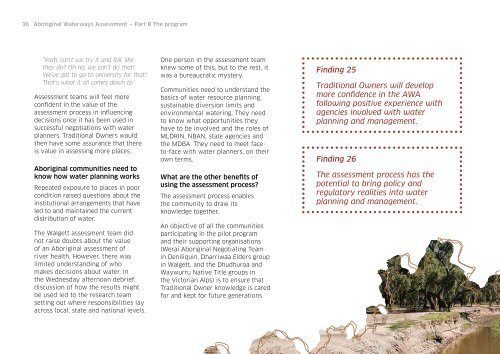Aboriginal Waterways Assessment program
dCckIF
dCckIF
You also want an ePaper? Increase the reach of your titles
YUMPU automatically turns print PDFs into web optimized ePapers that Google loves.
36 <strong>Aboriginal</strong> <strong>Waterways</strong> <strong>Assessment</strong> — Part B The <strong>program</strong><br />
‘Yeah, can’t we try it and fail, like<br />
they do? Oh no, we can’t do that!<br />
We’ve got to go to university for that!<br />
That’s what it all comes down to.’<br />
<strong>Assessment</strong> teams will feel more<br />
confident in the value of the<br />
assessment process in influencing<br />
decisions once it has been used in<br />
successful negotiations with water<br />
planners. Traditional Owners would<br />
then have some assurance that there<br />
is value in assessing more places.<br />
<strong>Aboriginal</strong> communities need to<br />
know how water planning works<br />
Repeated exposure to places in poor<br />
condition raised questions about the<br />
institutional arrangements that have<br />
led to and maintained the current<br />
distribution of water.<br />
The Walgett assessment team did<br />
not raise doubts about the value<br />
of an <strong>Aboriginal</strong> assessment of<br />
river health. However, there was<br />
limited understanding of who<br />
makes decisions about water. In<br />
the Wednesday afternoon debrief,<br />
discussion of how the results might<br />
be used led to the research team<br />
setting out where responsibilities lay<br />
across local, state and national levels.<br />
One person in the assessment team<br />
knew some of this, but to the rest, it<br />
was a bureaucratic mystery.<br />
Communities need to understand the<br />
basics of water resource planning,<br />
sustainable diversion limits and<br />
environmental watering. They need<br />
to know what opportunities they<br />
have to be involved and the roles of<br />
MLDRIN, NBAN, state agencies and<br />
the MDBA. They need to meet faceto-face<br />
with water planners, on their<br />
own terms.<br />
What are the other benefits of<br />
using the assessment process?<br />
The assessment process enables<br />
the community to draw its<br />
knowledge together.<br />
An objective of all the communities<br />
participating in the pilot <strong>program</strong><br />
and their supporting organisations<br />
(Werai <strong>Aboriginal</strong> Negotiating Team<br />
in Deniliquin, Dharriwaa Elders group<br />
in Walgett, and the Dhudhuroa and<br />
Waywurru Native Title groups in<br />
the Victorian Alps) is to ensure that<br />
Traditional Owner knowledge is cared<br />
for and kept for future generations.<br />
Finding 25<br />
Traditional Owners will develop<br />
more confidence in the AWA<br />
following positive experience with<br />
agencies involved with water<br />
planning and management.<br />
Finding 26<br />
The assessment process has the<br />
potential to bring policy and<br />
regulatory realities into water<br />
planning and management.


